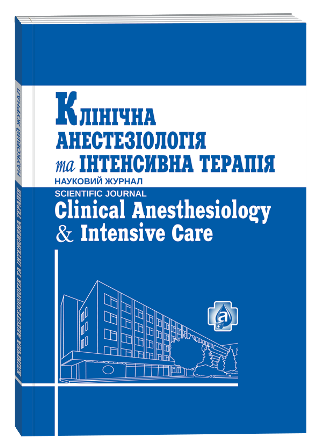ROLE OF EXTRACORPOREAL THERAPIES IN CRITICALLY ILL PATIENTS WITH SARS-COV-2
DOI:
https://doi.org/10.31379/2411.2616.17.1.1Keywords:
extracorporeal therapy, COVID-19, hemoperfusion, plasma separation, hemodiafiltration, chest MSCT, consolidation, ground-glass opacitiesAbstract
Aim. To analyze the experience of using extracorporeal therapies to treat patients with SARS-CoV-2. Methods. 48 extracorporeal procedures were performed in 27 patients with a laboratory confirmed SARS-CoV-2, bilateral pneumonia, and various concomitant chronic diseases. All patients had the mean SOFA score of 8.1 ± 3.1 [min 3, max 16] at admission in the ICU. 19 patients (70.4%) had severe lung injury over 75% according to the chest CT scans. Indications for extracorporeal therapies initiation included cytokine storm associated with acute respiratory distress syndrome (ARDS) and septic shock. Results. Overall, each patient received at least one extracorporeal therapy. 11 patients underwent 2 to 6 sessions. Isolated plasma separation and hemoperfusion allowed reducing vasopressor / cardiotonic support, slightly improved ventilation parameters, with a significant, but not prolonged decrease in the levels of inflammation markers. The combination of methods that provide rapid elimination of agents, with prolonged correction of homeostasis and detoxification, with controlled temperature response and hydration, appeared to be the most rational. Extracorporeal therapy did not improve the volume and severity of damaged lung parenchyma. 19 (70.4%) patients who received extracorporeal therapy were transferred from mechanical ventilation to spontaneous breathing, whereas 8 (29.6%) patients had severe lung lesions over 75% according to the repeated chest CT scans. The mean length of stay in the ICU among survivors was 9 ± 3.5 [min 4 max 22]. The 28-day mortality and in-hospital mortality rate was 25.9% (7). Conclusion. Prolonged extracorporeal therapy in patients with SARSCov- 2 have demonstrated efficacy in relieving organ dysfunctions and shock states, but did not significantly improve the severity of damaged lung parenchyma.
References
Potential effect of blood purification therapy in reducing cytokine storm as a late complication of critically ill COVID-19. / J. Ma [et al.] // Clin Immunol. – 2020. – P. 214. doi: 10.1016/j.clim.2020.108408.
Clinical features of patients infected with 2019 novel coronavirus in Wuhan, China. / C. Huang [et al.] // Lancet. – 2020. – Vol. 395(10223). – P. 497-506. doi: 10.1016/S0140-6736(20)30183-5.
Risk Factors Associated With Acute Respiratory Distress Syndrome and Death in Patients With Coronavirus Disease 2019 Pneumonia in Wuhan, China. / C. Wu [et al.] // JAMA Intern Med. – 2020. – Vol. 180(7). – P. 1–11. doi: 10.1001/jamainternmed.2020.0994.
Rubtsov, M.S., Shukevich, D.L. Modern extracorporeal methods for critical conditions caused by systemic inflammatory response (review). Russian Journal of Anaesthesiology and Reanimatology (Anesteziologiya I Reanimatologiya). – 2019. – Vol. 4. – P. 20-30. (In Russ.). https://doi.org/anaesthesiology201904120.
Mustafa, S., Balkhy, H., Gabere, M.N. Current treatment options and the role of peptides as potential therapeutic components for Middle East Respiratory Syndrome (MERS): A review. J Infect Public Health. – 2018. – Vol. 11(1). – P. 9-17. doi:10.1016/j.jiph.2017.08.009.
Practical recommendations of the Association of Anesthesiologists and Resuscitators and the public organization “Russian Sepsis Forum” on the use of extracorporeal hemocorrection in patients with COVID-19 (Version 1.0 from 20.04.2020) https://association-ar.ru/wp-content/uploads/2020/04/%D0%AD%D0%9C%D0%9B-%D0%BF%D1%80%D0%B8-COVID-%D1%80%D0%B5%D0%BA%D0%BE%D0%BC%D0%B5%D0%BD%D0%B4%D0%B0%D1%86%D0%B8%D0%B8.pdf
Temporary guidelines: prevention, diagnosis and treatment of a new coronavirus infection (COVID-19) // Ministry of Health of the Russian Federation 06/03/2020. URL: http://static-0.rosminzdrav.ru/system/attachments/attaches/000/050/584/original/03062020_%D0%9CR_COVID-19_v7.pdf
High risk of thrombosis in patients with severe SARS-CoV-2 infection: a multicenter prospective cohort study. / J. Helms [et al.] // Intensive Care Med. – 2020. – Vol. 46(6). – P. 1089-1098. doi:10.1007/s00134-020-06062-x
D-dimer levels on admission to predict in-hospital mortality in patients with Covid-19. / L. Zhang [et al.] // J Thromb Haemost. – 2020. – Vol. 18(6). – P. 1324-1329. doi:10.1111/jth.14859
Assessing efficacy of CytoSorb haemoadsorber for prevention of organ dysfunction in cardiac surgery patients with infective endocarditis: REMOVE-protocol for randomised controlled trial. / M. Diab [et al.] // BMJ Open. – 2020. – Vol. 10(3). – e031912. doi:10.1136/bmjopen-2019-031912
Therapeutic plasma exchange in patients with COVID-19 pneumonia in intensive care unit: a retrospective study. / B. Gucyetmez [et al.] // Crit Care. – 2020. – Vol. 24(1). – P. 492. doi:10.1186/s13054-020-03215-8
A novel treatment approach to the novel coronavirus: an argument for the use of therapeutic plasma exchange for fulminant COVID-19. / P. Keith [et al.] // Crit Care. – 2020. – Vol. 24(1). – P. 128. doi:10.1186/s13054-020-2836-4
Kang, J.H. Multiscale Biofluidic and Nanobiotechnology Approaches for Treating Sepsis in Extracorporeal Circuits. Biochip J. – 2020. – Vol. 12. – P. 1-9. doi: 10.1007/s13206-020-4106-6.
Davenport, A., Tolwani, A. Citrate anticoagulation for continuous renal replacement therapy (CRRT) in patients with acute kidney injury admitted to the intensive care unit. NDT Plus. – 2009. – Vol. 2(6). – P. 439-447. doi:10.1093/ndtplus/sfp136
Continuous Renal Replacement Therapy and Extracorporeal Membrane Oxygenation in Cardias Surgery. / S. Kolesnikov [et al.] // General Reanimatology. – 2014. – Vol. 10(3). – P. 75-84. https://doi.org/10.15360/1813-9779-2014-3-75-84
The origin, transmission and clinical therapies on coronavirus disease 2019 (COVID-19) outbreak – an update on the status. / Y.R. Guo [et al.] // Mil Med Res. – 2020. – Vol. 7(1). – P. 11. doi: 10.1186/s40779-020-00240-0.
Endothelial cell infection and endotheliitis in COVID-19. / Z. Varga [et al.] // Lancet. – 2020. – Vol. 395(10234). – P. 1417-1418. doi: 10.1016/S0140-6736(20)30937-5.







